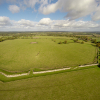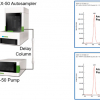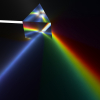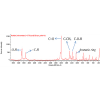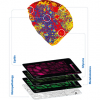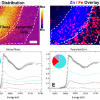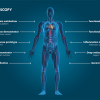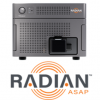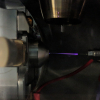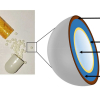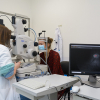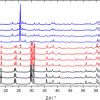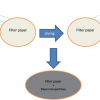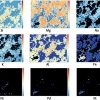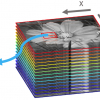Articles
Researchers from Technische Universität Dresden, reveal new insights into protonated mono and polyamines' behavior by determining pKa values using Fourier transform infrared titration, providing valuable data for chemical analysis.
Under the direction of Editor and Publisher Ian Michael, Spectroscopy Europe, and Spectroscopy World, have been writing about the latest trends in analytical sciences since 1975.
This article describes how gamma-ray spectroscopy can reveal new features in buried archaeological sites. In her case at the Roman settlement of Silchester in Hampshire, UK, and other sites.
LC/MS/MS analysis of PFAS at ultra-trace levels requires mitigation to both liquid chromatograph and mass spectrometer to eliminate the leaching of fluorochemicals from components within the systems. Manual SPE configurations also require mitigative steps to eliminate any components constructed of PTFE to minimise or eliminate any PFAS contamination.
Non-linear spectroscopy can have various applications in different fields due to the accuracy and resolution it provides. This article describes a few possible applications that show the importance of non-linear spectroscopy.
A Raman spectroscopy method was optimised to examine the chemical changes of aspirin tablets after interaction with helium temperatures.
This article describes MALDI imaging’s potential uses in pathology applications, and the benefits of the technique to map hundreds of biomolecules (proteins, lipids and glycans, for example) in a label-free, untargeted manner or for imaging target proteins using a modified immunohistochemistry protocol, often from a single tissue section.
This article describes the use of synchrotron X-ray fluorescence and absorption spectroscopies to image metals in the brain.
Despite a multitude of chemical and physical methods capable of detecting fingerprint residues, there are substantial challenges with fingerprint recovery. Spectroscopic methods have played a critical role in the analysis of fingerprints, used to identify the chemical constituents present, examine their degradation over time and compare the chemical variation between donors.
This article is about photoacoustic imaging and spectroscopy, and their use for looking inside us, where they have a number of benefits. Hilde Jans and Xavier Rottenberg explain the fundamentals and how new technology may be bringing a new photoacoustics age.
This sponsored article describes the RADIAN ASAP, a dedicated direct analysis system, which uses Atmospheric Pressure Solids Analysis Probe (ASAP) technology to analyze solids, liquids and solutions.
The authors have developed the “GlowFlow” mass spectrometry source design based on an Argon flowing glow-discharge that can be retrofitted to existing instrumentation and ionise compounds at atmospheric pressure which are less amenable to ESI.
Once tablets and capsules have been removed from their original packing (which they often have to be), the possibility of certain identification is lost and mixups can happen. The authors have developed a database containing physical information about tablets/capsules and, crucially, ATR/FT-IR spectra. The spectra are usually able to narrow down the “prediction” to the correct medicine.
Eyes may or may not be the window into our souls, but it does seem that they are the window into our brains. This article explains how hyperspectral imaging (HSI) and optical coherence tomography (OCT) can be used to image the retina to diagnose Alzheimer’s Disease. The results are processed by machine learning and give the best performance when HSI and OCT data are combined.
Roman concrete is well known and has lasted well. Now, it seems that the Egyptians used concrete to build at least some of their pyramids. Guy Demortier reports that PIGE and PIXE analyses have revealed the presence of carbon clusters in the material used to build the Khufu (Great) pyramid at Giza. This fits with a model of construction in which the blocks were cast in situ rather than cut out of stone and somehow moved into place. There’s always something new to be learnt!
Holger Gibhardt, Fabian Ziegler and Götz Eckold tell us about the use of Raman spectroscopy to understand complex electric and magnetic interactions in multiferroic ionic crystals. Multiferroics are a relatively new class of materials that exhibit magnetic and electrical ordering simultaneously. Both phenomena are coupled so that electric forces may be used to control the magnetic structure and vice versa. Raman enables understanding of the underlying processes on the atomic level, essential for the development of new materials with these properties.
Surface-enhanced Raman spectroscopy for selected energetic material detection is the topic of Mohamed Mokhtar, Tamer Wafy and Mahmoud Abdelhafiz. They have investigated various approaches to improve the SERS response of explosive materials and have come up with a simpler, one-step method for the detection of natural, solid TNT.
Whether it is looking at geological samples to exploit potential mineral deposits, identifying the provenance of gemstones or exploring the surface of Mars, LIBS has proven to be a valuable technique. The ability to take the instrument into the field with the development of handheld spectrometers has only enhanced its utility.
What should we be calling the various types of spectral imaging? The authors lay out some suggestions and welcome your views.
The SensorFINT COST Action is a European Network for assuring food integrity using non-destructive spectral sensors.



